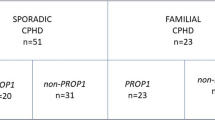Abstract
Combined pituitary hormone deficiency (CPHD), including growth hormone (GH), prolactin (Prl) and thyroid-stimulating hormone (TSH) in children is now considered a heterogeneous syndrome. Recent findings on expression of mouse pituitary-specific homeodomain factors demonstrate dependence of adenopituitary ontogeny on interactive expression of these factors, suggesting their involvement in etiology of CPHD. Prophet of Pit-1 (Prop-1) gene, a novel pituitary-specific homeodomain factor, was analyzed in 14 Russian children with CPHD, in whom Pit-1 gene was intact. We found a mutational hot spot in three patients from two families in homeodomain part of the second exon of Prop-1 gene. The common 2- base pair deletion (GA296) in the homozygous state resulted in a Serine to Stop codon (S109X) substitution and generated a truncated Prop-1 protein. Parents were phenotypically normal and heterozygous for GA296 deletion, indicating an autosomal recessive inheritance. These results demonstrate a novel type of Prop-1 gene mutation as one of the causes of CPHD in Russian patients.
Similar content being viewed by others
References
Sornson MW, Wu W, Dasen JS, Flynn SE, Norman DJ, O'Connell SM, Gukovsky I, Carriere C, Ryan AK, Miller AP, Zuo L, Gleiberman AS, Andersen B, Beamer WG, Rosenfeld MG. Pituitary lineage determination by the Prophet of Pit-1 homeodomain factor defective in Ames dwarfism. Nature 1996;384:327–333.
Sheng HZ, Zhadanov AB, Mosinger BJ, Fujii T, Bertuzzi S, Bertuzzi S, Grinberg A, Lee EJ, Huang S-P, Mahon KA, Westphal H. Specification of pituitary cell lineages by the LIM homeobox gene Lhx3. Science 1996;272:1004–1007.
Parks JS, Brown MR, Abdul-Latif H, Kinoshita E. Abnormalities of the pituitary-specific transcription factor-1 gene and protein. Clin Ped Endocrinol 1995;4:33–39.
Pfaffle RW, DiMattia GE, Parks JS, Brown MR, Wit JM, Jansen M, Van der Nat H, Van den Brande JL, Rosenfeld MG, Ingraham HA. Mutation of the POU-specific domain of Pit-1 and hypopituitarism without pituitary hypoplasia. Science 1992;257:1118–1121.
Li S, Crenshaw EB III, Rawson EJ, Simmons DM, Swanson LW, Rosenfeld MG. Dwarf locus mutants lacking three pituitary cell types result from mutations in the POU-domain gene Pit-1. Nature 1990;347:528–533.
Lin S-C, Lin CR, Gukovsky I, Lusis AJ, Sawchenko PE, Rosenfeld MG. Molecular basis of the little mouse phenotype and implications for cell type-specific growth. Nature 1993;364:208–213.
Szeto DP, Ryan AK, O'Connell SM, Rosenfeld MG. P-OTX: A Pit-1-interacting homeodomain factor expressed during anterior pituitary gland development. Proc Natl Acad Sci USA 1996;93:7706–7710.
Tuggle CK, Trenkle A. Control of growth hormone synthesis. Dom An Endocrinol 1996;13:1–13
Ingraham HA, Albert VR, Chen R, Crenshaw EB III, Elsholtz HP, He X, Kapiloff MS, Mangalam HJ, Swanson LW, Treacy MN, Rosenfeld MG. A family of POU-domain and Pit-1 tissue-specific transcription factors in pituitary and neuroendocrine development. Annu Rev Physiol 1990;52: 773–791
Hermesz E, Mackem S, Mahon KA. Rpx: A novel anteriorrestricted homeobox gene progressively activated in the prechordal plate, anterior neural plate and Rathke's pouch of the mouse embryo. Development 1996;122:41–52.
Andersen B, Pearse RV II, Jenne K, Sornson M, Lin S-C, Bartke A, Rosenfeld MG. The Ames dwarf gene is required for Pit-1 gene activation. Dev Biol 1995;172:495–503.
Wijnholds J, Chowdhury K, Wehr R, Gruss P. Segment-specific expression of the neuronatin gene during early hindbrain development. Dev Biol 1995;171:73–84.
Bach I, Rhodes SJ, Pearse RV II, Heinzel T, Gloss B, Scully KM, Sawchenko PE, Rosenfeld MG, P-Lim, a LIM homeodomain factor, is expressed during pituitary organ and cell commitment and synergizes with Pit-1. Proc Natl Acad Sci USA 1995;92:2720–2724.
Rhodes SJ, Chen R, DiMattia GE, Scully KM, Kalla KA, Lin S-C, Yu VC, Rosenfeld MG. A tissue-specific enhancer confers Pit-1-dependent morphogen inducibility and autoregulation on the Pit-1 gene. Genes Dev 1993;7:913–932.
Schonemann MD, Ryan AK, McEvilly RJ, O'Connell SM, Arias CA, Kalla KA, Li P, Sawchenko PE, Rosenfeld MG. Development and survival of the endocrine hypothalamus and posterior pituitary gland requires the neuronal POU domain factor Brn-2. Genes Dev 1995;9:3122–3135.
Lamonerie T, Tremblay JJ, Lanctot C, Therrien M, Gauthier Y, Drouin J. Ptx1, a bicoid-related homeo box transcription factor involved in transcription of the pro-opiomelanocortin gene. Genes Dev 1996;10:1284–1295.
Seidah NG, Barale J-C, Marcinkiewicz M, Mattei M-G, Day R, Chretien M. The mouse homeoprotein mLIM-3 is expressed early in cells derived from the neuroepithelium and persists in adult pituitary, DNA. Cell Biol 1994;13: 1163–1180.
Tatsumi K, Miyai K, Notomi T, Kaibe K, Amino N. Cretinism with combined hormone deficiency caused by a mutation in the Pit-1 gene. Nature Genet 1992;1:56–58.
Radovick S, Nations M, Du Y, Berg LA, Weintraub BD, Wondisford FE. A mutation in the POU-homeodomain of Pit-1 responsible for combined pituitary hormone deficiency. Science 1992;257:1115–1118.
Fofanova OV, Takamura N, Kinoshita E, Yoshimoto M, Tsuji Y, Peterkova OV, Evgrafov,Dedov II, Goncharov NP, Yamashita S. Rarity of Pit-1 gene involvement in children from Russia with combined pituitary hoermone deficiency. Am J Med Genet (in press).
Author information
Authors and Affiliations
Rights and permissions
About this article
Cite this article
Fofanova, O.V., Takamura, N., Kinoshita, Ei. et al. A Mutational Hot Spot in the Prop-1 Gene in Russian Children with Combined Pituitary Hormone Deficiency. Pituitary 1, 45–49 (1998). https://doi.org/10.1023/A:1009918924945
Issue Date:
DOI: https://doi.org/10.1023/A:1009918924945




